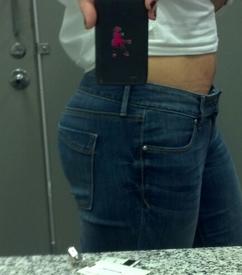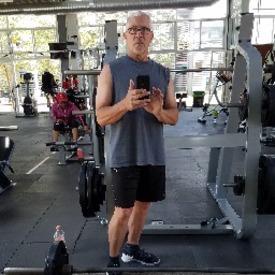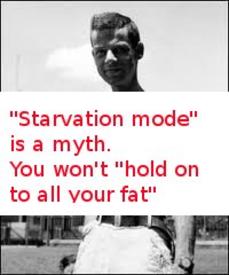Interval training vs Steady State; Fat Burning Zones

joejccva71
Posts: 2,985 Member
Good evening peeps. It's me, your "friendly" neighborhood bodybuilder who likes to not only be thorough but also get under everyone's skin. I'm the guy that keeps up with MOST of my friends regarding their diet & training. I may not critique them all the time, but I see things. (No I don't see dead people) I watch my friend's progress. I know who's 110% dedicated to making their transformation goals happen and who isn't and does things half *kitten*.
Anyways, the purpose of this newly created thread is for me to talk about CARDIO and how it holds it's place in your training and fat loss project. However, before I get started I want to talk about this "fat burning zone myth" people so quickly call it. The problem isn't whether or not the Fat Burning Zone is a myth, it's that people too often confuse percentages with absolutes.
As you move from low intensity cardio to high intensity the amount of fat vs carbs burned shifts from one to the other.
At low intensities, you MAY burn 100% fat.
At high intensities (or anything above the lactate threshold), you MAY burn 100% carbs.
At any intensity between, you MAY burn a portion between the two.
If you're walking at 3mph, and burning 5cals/min but you're burning 100% fat. That's 5cal/min of fat.
If you're running at 6mph, and burning 10cals/min but burning 50% fat.
People are thinking, but that's burning LESS fat? No it's not.
10 cal/min * 50% = 5 cal/min of fat
It's the same amount of fat in absolute terms although it's a lower percentage. But you're also burning 5 cal/min of carbohydrates. We'll also say that at 6 mph you're burning 10 cal/min but still 65% fat. That's still lower by percentages than at 3mph, but you're burning 6.5 cal/min of fat which is higher. Also you burn more TOTAL calories as well as depleting some of the carbs in your muscle.
When you're depleting muscle glycogen whether it's by exercise or carb restriction, you body will increase fat oxidation by ten-fold. Also it matters MORE what you burn the rest of the day versus what is burned during exercise and this is ESPECIALLY important for INTERVAL training.
This is more the reason for doing Interval Training (HIIT) in the first place because:
1. When doing interval training, your body burns MORE later on in the day.
2. When you eat carbs they tend to go more toward refilling muscle glycogen versus being used for energy.
To summarize:
Low intensity cardio = More direct fat burning effect as it burns fat for fuel but you don't get anything else out of it.
High intensity cardio = Burns a portion of fat + carbs and impacts greatly on what you burn later in the day.
Interval training = Burns only carbs during the actual interval training, but also depletes glycogen amazingly and HUGELY impacts what you burn later on in the day.
Also think of it this way:
A quick 5 minute (15 sec on / 45 sec off) HIIT training session causes fat to MOBILIZE from the fat cells.
A complete 5 minute rest causes fat transporting into the bloodstream to prep for oxidation
Steady state for 20-40 mins (120-140HR) causes direct FAT OXIDATION to take place since it's a DIRECT fat burner.
This is the simplest way of explaining it to people so they understand. If you have any questions, let me know. Also keep in mind that if you are incredibly obese then it doesn't matter AS MUCH as it does for people who are somewhat lean and are trying to get even leaner or better body composition.
Edit: I also want to remind everyone that NONE of this matters if you're not in a deficit and your diet isn't spot on. Just saying.
Anyways, the purpose of this newly created thread is for me to talk about CARDIO and how it holds it's place in your training and fat loss project. However, before I get started I want to talk about this "fat burning zone myth" people so quickly call it. The problem isn't whether or not the Fat Burning Zone is a myth, it's that people too often confuse percentages with absolutes.
As you move from low intensity cardio to high intensity the amount of fat vs carbs burned shifts from one to the other.
At low intensities, you MAY burn 100% fat.
At high intensities (or anything above the lactate threshold), you MAY burn 100% carbs.
At any intensity between, you MAY burn a portion between the two.
If you're walking at 3mph, and burning 5cals/min but you're burning 100% fat. That's 5cal/min of fat.
If you're running at 6mph, and burning 10cals/min but burning 50% fat.
People are thinking, but that's burning LESS fat? No it's not.
10 cal/min * 50% = 5 cal/min of fat
It's the same amount of fat in absolute terms although it's a lower percentage. But you're also burning 5 cal/min of carbohydrates. We'll also say that at 6 mph you're burning 10 cal/min but still 65% fat. That's still lower by percentages than at 3mph, but you're burning 6.5 cal/min of fat which is higher. Also you burn more TOTAL calories as well as depleting some of the carbs in your muscle.
When you're depleting muscle glycogen whether it's by exercise or carb restriction, you body will increase fat oxidation by ten-fold. Also it matters MORE what you burn the rest of the day versus what is burned during exercise and this is ESPECIALLY important for INTERVAL training.
This is more the reason for doing Interval Training (HIIT) in the first place because:
1. When doing interval training, your body burns MORE later on in the day.
2. When you eat carbs they tend to go more toward refilling muscle glycogen versus being used for energy.
To summarize:
Low intensity cardio = More direct fat burning effect as it burns fat for fuel but you don't get anything else out of it.
High intensity cardio = Burns a portion of fat + carbs and impacts greatly on what you burn later in the day.
Interval training = Burns only carbs during the actual interval training, but also depletes glycogen amazingly and HUGELY impacts what you burn later on in the day.
Also think of it this way:
A quick 5 minute (15 sec on / 45 sec off) HIIT training session causes fat to MOBILIZE from the fat cells.
A complete 5 minute rest causes fat transporting into the bloodstream to prep for oxidation
Steady state for 20-40 mins (120-140HR) causes direct FAT OXIDATION to take place since it's a DIRECT fat burner.
This is the simplest way of explaining it to people so they understand. If you have any questions, let me know. Also keep in mind that if you are incredibly obese then it doesn't matter AS MUCH as it does for people who are somewhat lean and are trying to get even leaner or better body composition.
Edit: I also want to remind everyone that NONE of this matters if you're not in a deficit and your diet isn't spot on. Just saying.
0
Replies
-
Thank you!!! ive been looking into this... or anything that makes the fat beg for mercy.0
-
I'm with Jules .. I want my fat to cry
 0
0 -
Wow thanks!
 0
0 -
Somebody has been reading Lyle McDonald :-)0
-
Somebody has been reading Lyle McDonald :-)
I've read all of his books atleast twice. 0
0 -
Great post as usual my friend

Just a question about this :Edit: I also want to remind everyone that NONE of this matters if you're not in a deficit and your diet isn't spot on. Just saying.
I may be wrong, but you can be in surplus while fasting, which would however allows the shift from cho metabolism to fat metabolism - being measured via the respiratory quotient (100% fat metabolism at 0.7) ?0 -
Awesome post!0
-
Great post as usual my friend

Just a question about this :Edit: I also want to remind everyone that NONE of this matters if you're not in a deficit and your diet isn't spot on. Just saying.
I may be wrong, but you can be in surplus while fasting, which would however allows the shift from cho metabolism to fat metabolism - being measured via the respiratory quotient (100% fat metabolism at 0.7) ?
Possibly, but overall won't matter, as the calorie surplus would most likely replace what you burn during the fast.0 -
Question - Can anyone give me some idea of a HIIT workout on a treadmill, as in how many mins sprint, jog, walk, and how long total to do the session for ?
Also, if you go biking, and it involves a lot of stopping, slowing, going up hills, speeding up etc, does that count as some form of interval training? Thanks.0 -
Thanks Man, very informative, love it and going to work with it! Cheers!0
-
bump0
-
bump for later0
-
Thanks!0
-
i hate bumping posts but i NEED to read this tomorrow. (i'll leave a more constructive comment then!)0
-
Great post Joe! particularly liked the explanation of fat mobilization and how to take advantage of it.0
-
0
-
I happened upon this - http://www.facebook.com/note.php?note_id=208278279201761 - which looks somewhat complex but here it is :-Question - Can anyone give me some idea of a HIIT workout on a treadmill, as in how many mins sprint, jog, walk, and how long total to do the session for ?
1. Warm up - 5 minute light jog and hip, ankle, knee circles
2. HIIT Treadmill Workout:
1 minute walk at 4mph and 2 incline
1 minute run at 8pmh and 2 incline
1 minute walk at 4mph and 2 incline
1 minute run at 9mph and 2 incline
1 minute walk at 4mph and 2 incline
1 minute sprint at 10mph and 2 incline
1 minute walk at 4mph and 2 incline
1 minute sprint at 11mph and 2 incline
1 minute walk at 4mph and 2 incline
1 minute sprint at 12 mph and 2 incline
90 second walk at 4mph and 2 incline
30 second sprint at 12 mph and 4 incline
90 second walk at 4mph and 2 incline
30 second sprint at 12 mph and 6 incline
2 minute walk at 4mph and 2 incline
30 second sprint at 12 mph and 8 incline
walk for 3 minutes to cool down
Note -
When there is 15 seconds left in the walk I put my feet on the sides of the treadmill, increase the speed to the desired level, and jump on the treadmill when its time.
As soon as the sprint is over I put my feet onto the sides of the treadmill, reduce speed to walk, and step back on the treadmill.
This method is much more efficient and effective than running while changing the speed.
3. Steady State low intensity cardio (65% heart rate): 25 minutes at 3.5mph and 3 incline0 -
I got that, and I was reading about how going slow up a gradient on a treadmill burns more fat per minute absolute www.freemotionfitness.com/wcsstore/Freemotion/Attachment/Education/Incline_Training.pdfit's that people too often confuse percentages with absolutes.
I have a slightly more obscure question, if I was to burn say 50 calories of fat and 100 calories of carbs in a cardio session and I was eating at a calorie deficit overall is this any advantage overall compared to burning 20 calories of fat and 130 of carbs ?
Presumably the carbs from glucogen are replaced quickly but then they aren't available for anything else so the fat gets used over the day anyway to provide the energy balance.
So is the tactical increase in fat burn during a workout the same as a strategic benefit over the day, or is it conceptually possible that one is better off burning more calories in total during exercise even if this means less fat burnt during exercise ?0 -
Thanks for this post!0
-
I enjoy doing Tabatas early in the morning.
Thats also an intervall-training which goes like this:
20 sec Workout
10 sec Rest
Repeat 8 Times.
So thats only 4 Minutes a day but you can feel and see the difference so soon!
I got the excercises form Youtube. Just google "burn fat fast tabata youtube".
Nice greetings from Austria ;-)0 -
That's for the great advice! I'm trying to fat burn as much as possible at the moment using the Steps Machine, Cross Trainer and Rowing Machine. Would you be able to help me out with any tips on how to increase fat burn and what excercises, food are best for me at the moment? Aming for trim and lean at the moment!
 0
0 -
I eat at maintenance as i was losing muscle on a deficit & my weight was stalling. I'm doing okay now. So, would you reccomend doing HiIT before lifting heavy? Or would it be as effective if i was to do it late in the day?0
-
HIIT and strength should probably be done on diffferent days as both have an impact on your central nervous system.0
-
HIIT (treadmill intervals) is my only form of cardio, I've had great results, but I only do it on days I am not lifting or only lifting arms/shoulders. IMO, you can't do legs or back with HIIT, both are so intense on the legs and back.0
-
Thanks for the info
 0
0 -
I'm going to be copying this and distributing it to my step class participants. We work interval training during step and I'm big on telling them to take full advantage of the active rest and really push the high intensity to the max for the most benefit. They look at their hrm and think "but if I keep this thing up at 1xx, instead of letting it drop down I'll burn less calories." They don't finish that sentence with the " . . . for now, but more later."0
-
This is such great info! Though it may not apply to me so much right now as I have a lot to lose, I love learning new stuff. Hopefull, I'll be able to apply this one day. :happy:0
-
Thanks for this excellent post. Useful information!0
-
Hi,
I have understood your explanation: thank you for that.
However, there is something that I do not understand (and that makes a huge difference).
You have given the following example:
"If you're running at 6mph and burning 10cals/min but burning 50% fat."
Here what is really confusing me: who says that at 10cals/min you burn 50%of fat?
Who has established that number (50%)?
Couldn't it be that at 10 cals/min you burn just 15% (or any other percentage) of fat?
I'm helpless at maths so am I missing something here?
Cheers
:sad:0
This discussion has been closed.
Categories
- All Categories
- 1.4M Health, Wellness and Goals
- 394.8K Introduce Yourself
- 44K Getting Started
- 260.6K Health and Weight Loss
- 176.2K Food and Nutrition
- 47.5K Recipes
- 232.7K Fitness and Exercise
- 444 Sleep, Mindfulness and Overall Wellness
- 6.5K Goal: Maintaining Weight
- 8.6K Goal: Gaining Weight and Body Building
- 153.2K Motivation and Support
- 8.2K Challenges
- 1.3K Debate Club
- 96.4K Chit-Chat
- 2.5K Fun and Games
- 4.1K MyFitnessPal Information
- 16 News and Announcements
- 1.3K Feature Suggestions and Ideas
- 2.8K MyFitnessPal Tech Support Questions



















